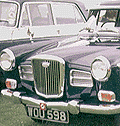 |
British Motor Corporation |
 |
The BMC Story
BMC was born out of an amalgamation of two already huge concerns, Nuffield Motors (Morris) and Austin in 1952. To be fair it was more of a takeover of Morris by Austin, the latter continuing to have more influence throughout the BMC term and on into BL (British Leyland) days. Perhaps as some consolation to the Nuffield school, many of the Austin managers were ex - Nuffield men and this probably helped the coming together. Indeed Lord Austin had died 11 years prior to the merger and William Morris (Lord Nuffield) was still alive, albeit 75 years old. Lord Nuffield was made President of BMC, but the post of Chairman and Managing Director went to the then head of Austin, Leonard Lord. Both manufacturers had their own separate infrastructures of course, and the formidable task of unifying the two must have been a daunting challenge. In some ways, the decision was taken to opt for the safe middle ground by keeping the whole operation very much as it had been by rationising the ranges by 'badge engineering' what were essentially the same cars. It is true to say that in the 1950's, the generation buying cars at that time were faithful to certain marques (and models to an extent) and by pandering to their needs, BMC planned to maintain market share. The drive to export was still strong since the post war austerity days and a good percentage of production was heading for more distant shores. As the 50's progressed, BMC was beginning to get a reputation for producing stuffy and uninspiring cars. To counter this, the services of the Italian Pininfarina design house were enlisted to inject some life into the next generation of models. In September 1958, the first car so designed appeared on the market, the 'Farina' A40. Powered by the enlarged 948cc 'A' series engine, the car was of the 'two box' format, refering to it's appearance in profile. The Morris Oxford IV and all it's badged cousins also appeared in the late 50's to reaffirm the new Farina look. It may be possible to peg some of the fundamental problems that dogged the British car industry at this point, since from a relatively uncomplicated range at the outset, models were now beginning to overlap within a single marque (A35/A40) and were also becoming uncompetitive - the Farina Oxford/Cambridge were well under powered and ponderous and were not well received by press and public alike. During the last half of the decade, there was one project which was born partly out of the fuel shortage brought on by the Suez Crisis and partly by the a passion for smaller cars. Having produced the successful Minor in 1948, Alec Issigonis had again been busy and in an impressively short development period launched the timeless Mini on the world. Dealer rivalry still prevailed and was compounded even further when the car was announced as an Austin Seven before subsequently being badged as a Morris Mini Minor to satisfy everyone. BMC management was now creaking at the seems trying to manage it's empire, endeavouring to hold the UK operation together as well as newer plants in Europe and Australia. The diverse nature of marques and models compounded this although signs were beginning to appear that BMC was trying to sort out the mess. The plan was to provide a cohesive range of models with which to address the key parts of the market. The next step toward this goal was the Issigonis/Farina designed 1100 which continued to enjoy great success well into the Leyland days. Next was the 1800 which probably missed the market slot it was intended for by being a little too large, too heavy and wrongly perceived through poor marketing. Overall it wasn't a bad car, if somewhat uninspiring. By now the swinging 60's had arrived and whilst the Mini became a 'scene' car, BMC had become ponderous and was losing touch with the market. In line with earlier policy, the next model up from the 1800 had been designed to address the more upmarket sector. To say this car had a lukewarm reception is overstating the point. The '3 litre' effectively used the centre section of the 1800 and had extended front and rear cavities to accommodate the larger engine and to provided more boot space - or was it just so it looked bigger? The net result was a car that had no more room than the 1800, went little faster, used more fuel and cost more to boot. The car was if anything a telling statement on the health of BMC at launch in 1967. The company was fighting a rearguard action to compete with the likes of Ford who were far more dynamic in their assault on the market. That isn't to say that BMC didn't still have a sizeable share of the market, but the company had no new products of note to offer for the 70's and still had cars in production that should have been phased out years before. In 1968, the company became British Leyland after a short period in limbo as British Motor Holdings and gradually transformed into what it is today, the Rover Group, a part of BMW.
It is interesting to speculate about how BMC could have become a world player today in it's own right. A lot of what has been written about the ultimate demise of the UK car industry looks at the symptoms rather than the actual problem. One can point a finger at 'Red' Robbo (Union leader) or Sir Michael Edwards (BL Chief exec.) or one of many figureheads within the organisation. As the 50's drew to a close, other players were moving into the market and they were starting to offer cars which should have set the warning bells ringing in BMC. The buying public was also getting more discerning, partly as a result of this, and partly because the more free and easy culture of the 60's was starting to assert itself. BMC couldn't rely on customer loyalty alone to carry them through. The choice of cars was also becoming rather confusing and if it wasn't for the niche and the 'feel good' factor created by the Mini the demise may have come much sooner. The Mini certainly was British innovation at it's finest, but did not initially form part of any coherent strategy. Scant regard was given to costs, and margins appear to have been insufficient to enable proper reinvestment in new models notwithstanding the inefficiencies in the organisation. Companies such as Ford meantime, were homing in on the UK market more and more and steadily reducing the whole 'concept to market cycle' enabling them to be more dynamic and hence responsive. That's not to say that other manufacturers didn't have their problems of course. Look at the rust problems Vauxhall had in the 50's and 60's, likewise Renault with their Dauphine. In a nutshell, BMC was engineering driven and autocratic, more concerned with internal politics than the outside world. Finally, BMC's policy of letting the customer finish the final testing of the vehicle was a sign of a company definitely out of control. But even reliability issues were probably a symptom of the chaotic nature of BMC, something which continued unabated into BL days. The Maxi was a prime example of this, the press having a field day pulling the car to bits at launch, but ultimately proving to be a satisfactory car 10 years later when withdrawn from production - too late by far. How could BMC have done it better? From a product perspective they should have rationalised the range early on to form a tangible thread running through the line. The Minor should have been dropped as the 1100 was launched and the Farina Oxford/Cambridge range never built, or leastways dropped when the 1800 was launched. Even then, many marque/model issues would still have existed but at least the picture would have been clearer. Proper reinvestment would also have been possible had margins been greater and a healthier company would have attracted more money from investors too. Even then, no-one could say that the company would not have been ripe for acquisition from foreign companies - we do seem rather good in this country of selling the family china. Also, reviewing the distribution/dealer tiers would have helped since it appears that many model decisions were taken on the strength of gut reaction from this network rather than proper market intelligence. The historical issue of separate Morris and Austin dealers should certainly have been sorted out at an early stage since BMC policy seems to have been driven too much by this arrangement. So what we have now is a number of small car makers addressing niche markets. But, then again, perhaps that's what we're good at......... Personally? I have to say that there is something about the cars that oozes character and at the same time embodies a certain quaint Britishness - not in a jingoistic way but as a reminder to us of our engineering heritage. Whether you own a practical 1100 or an impractical 3 Litre, enjoy. |


